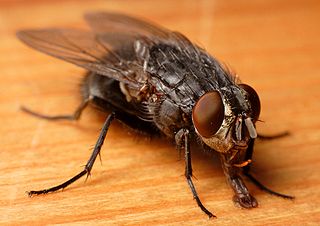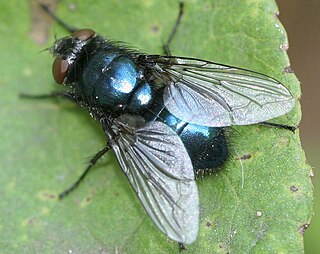
The Calliphoridae are a family of insects in the order Diptera, with almost 1,900 known species. The maggot larvae, often used as fishing bait, are known as gentles. The family is known to be polyphyletic, but much remains disputed regarding proper treatment of the constituent taxa, some of which are occasionally accorded family status.

Cluster flies are flies of the genus Pollenia in the family Polleniidae. Unlike the more familiar blow flies, such as the bluebottle genus Phormia they do not lay eggs in human food. They parasitise earthworms; the females lay their eggs near earthworm burrows, and the larvae then feed on the worms. But the biology of this group is relatively poorly known and a few have been recorded from other hosts including caterpillars and bees.

André Jean Baptiste Robineau-Desvoidy was a French physician and entomologist specialising in the study of Diptera (flies) and to some extent of the Coleoptera (beetles).

Calliphora is a genus of blow flies, also known as bottle flies, found in most parts of the world, with the highest diversity in Australia. The most widespread species in North America area Calliphora livida, C. vicina, and C. vomitoria.

Calliphora vicina is a member of the family Calliphoridae, which includes blow flies and bottle flies. These flies are important in the field of forensic entomology, being used to estimate the time of a person's death when a corpse is found and then examined. C. vicina is currently one of the most entomologically important fly species for this purpose because it arrives at and colonizes a body following death in consistent timeframes.
Lucilia thatuna belongs to the family Calliphoridae, the species most commonly referred to as the blowflies, and the genus Lucilia. Along with several other species of Lucilia, L. thatuna is commonly referred to as a green bottle fly. L. thatuna is very scarce and not much is known about this particular fly. It has been noted to reside in mountainous regions of the northwestern United States.

Calliphora livida is a member of the family Calliphoridae, the blow flies. This large family includes the genus Calliphora, the "blue bottle flies". This genus is important in the field of forensic entomology because of its value in post-mortem interval estimation.

Protophormia terraenovae is commonly called northern blowfly, blue-bottle fly or blue-assed fly. It is distinguished by its deep blue coloration and large size and is an important species throughout the Northern Hemisphere. This fly is notable for its economic effect as a myiasis pest of livestock and its antibiotic benefits in maggot therapy. Also of interest is P. terraenovae’s importance in forensic investigations: because of their temperature-dependent development and their prominent presence on corpses, the larvae of this species are useful in minimum post-mortem interval (mPMI) determination.

Melinda is a genus of flies in the family Calliphoridae. In general little is known of their biology. A few species have been reared from snails. One – Melinda gentilis – is parasitic in the snails Helicella virgata and Goniodiseus rotundata and Melinda itoi is a parasite of the snail Acusta despecta sieboldiana.
Aphria is a genus of fly in the family Tachinidae.

Rutilia is a large genus of medium to large (>20mm) flies in the family Tachinidae native to Australia and the Oriental region, though notably absent from New Zealand. Like the vast majority of tachinid flies, Rutilia species are parasitoids of other insects, specifically Rutilia are known to be parasitoids of late instar larvae of scarab beetles.

Eryciini is a tribe of flies in the family Tachinidae

Ernestiini is a tribe of flies in the family Tachinidae.

Lucilia gemma is a species of fly that belongs to the family Calliphoridae, the species most commonly referred to as the blowflies, and the genus Lucilia. Along with several other species of Lucilia, L. gemma is commonly referred to as a green bottle fly. The species is only known to be native to France.
Cosmina is a genus of flies in the family Rhiniidae.

Polleniidae is a family of flies in the order Diptera. There are at least 6 genera and more than 190 described species placed definitively in Polleniidae, and other genera whose placement here is considered uncertain. The largest genus is Pollenia, with close to 190 species of flies commonly called "cluster flies".

Rhiniidae is a family of flies in the order Diptera, and formerly included in the Calliphoridae. There are around 30 genera and 370 described species in Rhiniidae.
Compsomyiops is a genus of blowflies, in the family Calliphoridae.

Chrysomya marginalis, the regal blowfly, also referred to as the regal bluebottle or the bordered blowfly is an uncommon and relatively large species of fly that was described by Weidemann in 1830. It is found in Africa to the south of the Sahara, and is also found in various Middle-Eastern countries.

Amenia is a genus of flies belonging to the family Calliphoridae.

















